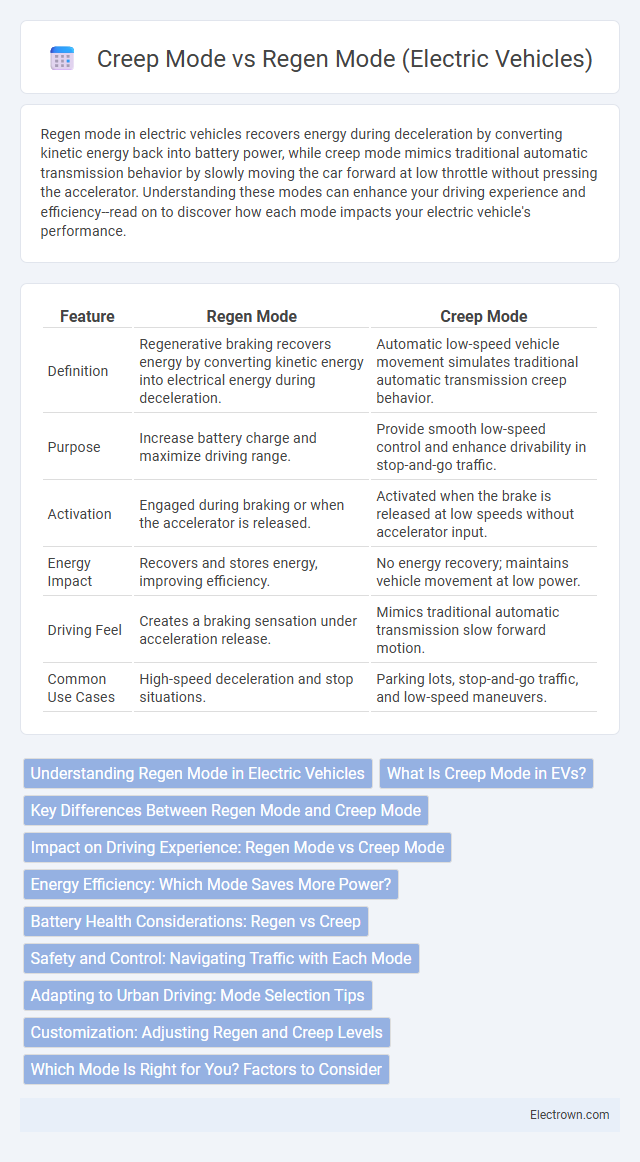Regen mode in electric vehicles recovers energy during deceleration by converting kinetic energy back into battery power, while creep mode mimics traditional automatic transmission behavior by slowly moving the car forward at low throttle without pressing the accelerator. Understanding these modes can enhance your driving experience and efficiency--read on to discover how each mode impacts your electric vehicle's performance.
Table of Comparison
| Feature | Regen Mode | Creep Mode |
|---|---|---|
| Definition | Regenerative braking recovers energy by converting kinetic energy into electrical energy during deceleration. | Automatic low-speed vehicle movement simulates traditional automatic transmission creep behavior. |
| Purpose | Increase battery charge and maximize driving range. | Provide smooth low-speed control and enhance drivability in stop-and-go traffic. |
| Activation | Engaged during braking or when the accelerator is released. | Activated when the brake is released at low speeds without accelerator input. |
| Energy Impact | Recovers and stores energy, improving efficiency. | No energy recovery; maintains vehicle movement at low power. |
| Driving Feel | Creates a braking sensation under acceleration release. | Mimics traditional automatic transmission slow forward motion. |
| Common Use Cases | High-speed deceleration and stop situations. | Parking lots, stop-and-go traffic, and low-speed maneuvers. |
Understanding Regen Mode in Electric Vehicles
Regen mode in electric vehicles harnesses kinetic energy during braking, converting it into electrical energy to recharge the battery and extend driving range. This mode improves energy efficiency by allowing the vehicle to recover power that would otherwise be lost as heat in traditional braking systems. Understanding how regen mode integrates with your driving habits can maximize battery life and optimize overall vehicle performance.
What Is Creep Mode in EVs?
Creep mode in electric vehicles simulates the slow forward movement experienced in traditional automatic transmissions when the brake is released without pressing the accelerator. This feature enhances low-speed maneuverability, especially in stop-and-go traffic or parking situations, by providing a gentle, continuous propulsion. Creep mode improves driver control and comfort by mimicking familiar behavior from conventional gasoline-powered cars.
Key Differences Between Regen Mode and Creep Mode
Regen mode in electric vehicles focuses on energy recovery by converting kinetic energy into electrical energy during deceleration, enhancing battery efficiency. Creep mode mimics traditional automatic transmission behavior by applying a small amount of torque to move the vehicle slowly without pressing the accelerator, improving low-speed maneuverability. Regen mode actively slows the vehicle through regenerative braking, while creep mode passively maintains movement to aid smooth starts and stops.
Impact on Driving Experience: Regen Mode vs Creep Mode
Regen mode in electric vehicles enhances the driving experience by converting kinetic energy into electrical energy, providing a stronger deceleration feel and reducing brake wear, which results in smoother downshifting and more controlled slowing without pressing the brake pedal. Creep mode simulates traditional automatic transmission behavior by causing the vehicle to slowly move forward when the brake is released, offering familiarity to drivers but less energy recovery and potentially less efficient driving. The choice between regen and creep modes significantly affects energy efficiency and driver engagement, with regen mode promoting a more dynamic and eco-friendly ride.
Energy Efficiency: Which Mode Saves More Power?
Regen mode in electric vehicles captures kinetic energy during deceleration and converts it into stored battery power, enhancing overall energy efficiency by reducing energy waste. Creep mode, which simulates traditional automatic transmission behavior by moving the vehicle slowly at low speeds without accelerator input, consumes more energy as it continuously draws power to maintain motion. Your EV conserves more power in Regen mode as it actively recovers energy, making it the superior choice for maximizing energy efficiency.
Battery Health Considerations: Regen vs Creep
Regen mode actively recovers energy during braking by converting kinetic energy into electrical energy, contributing to battery health by reducing deep discharge cycles and enhancing overall efficiency. Creep mode maintains a low-speed vehicle movement using minimal electric power without regenerative benefits, leading to slightly more frequent battery discharges. Prioritizing regen mode supports longer battery lifespan through optimized charge cycles and reduced thermal stress compared to creep mode.
Safety and Control: Navigating Traffic with Each Mode
Regen mode in electric vehicles enhances safety by automatically slowing the car when releasing the accelerator, improving control during stops and reducing reliance on brake pads. Creep mode simulates traditional automatic transmission behavior by maintaining a slow forward motion when the brake is released, offering consistent low-speed maneuverability in traffic. Choosing regen mode provides better energy efficiency and smoother deceleration, while creep mode offers familiar handling for drivers accustomed to combustion engine vehicles.
Adapting to Urban Driving: Mode Selection Tips
Regen mode in electric vehicles enhances energy recovery by increasing regenerative braking, ideal for stop-and-go urban traffic where frequent deceleration occurs. Creep mode mimics traditional automatic transmission behavior, providing smooth, constant low-speed movement, beneficial for tight city maneuvers like parking or heavy traffic congestion. Selecting regen mode maximizes battery efficiency during prolonged urban driving, while creep mode ensures precise control and comfort in slow-speed conditions.
Customization: Adjusting Regen and Creep Levels
Electric vehicles offer customization options for Regen mode and Creep mode, allowing drivers to adjust the intensity and responsiveness to suit their driving style. Regen level adjustments control the amount of energy recovered during deceleration, optimizing battery efficiency and enhancing driving range. Creep mode customization regulates the vehicle's low-speed movement behavior when the brake is released, providing smoother starts and better control in stop-and-go traffic conditions.
Which Mode Is Right for You? Factors to Consider
Regen mode in electric vehicles recovers energy during braking, extending battery range and enhancing efficiency, making it ideal for drivers prioritizing eco-friendly performance and frequent stop-and-go traffic. Creep mode simulates traditional automatic transmission behavior by providing low-speed creep without accelerator input, beneficial for drivers seeking familiar driving dynamics and smoother parking maneuvers. Consider personal driving habits, battery range needs, and comfort preferences when choosing between regen and creep modes for optimal EV operation.
Regen mode vs Creep mode (electric vehicles) Infographic

 electrown.com
electrown.com